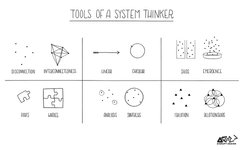
Tools for Systems Thinkers: The 6 Fundamental Concepts of Systems Thinking

Dr. Anabel Fernandez Santana on LinkedIn: This graph by the Griffith Centre for Systems Innovation illustrates what…
linkedin.com
systems thinking encompasses a large and fairly amorphous body of methods, tools, and principles, all oriented to looking at the interrelatedness of forces, and seeing them as part of a common process.
Art Kleiner • The Fifth Discipline Fieldbook: Strategies for Building a Learning Organization
As long as the broader we continue to see things as inherently, essentially distinct, systems thinking will remain a primarily academic or specialist practice — a set of tools rather than a paradigm-shifting force.
Medium • The Ecosystem Hypothesis
these diverse approaches have one guiding idea in common: that behavior of all systems follows certain common principles, the nature of which are being discovered and articulated.